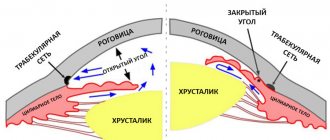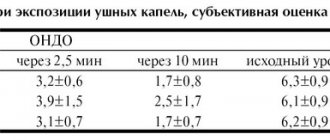In what cases is it used?
The drug is used as monotherapy in ophthalmology and as part of complex therapy for infectious ENT diseases.
Application in ophthalmology:
- inflammation caused by gram-positive and gram-negative bacteria, viruses, fungi (conjunctivitis, keratitis);
- treatment and prevention of inflammatory processes before and after eye surgery;
- prevention of gonococcal and chlamydial infections in newborns;
- burns of the mucous membrane of the eyes;
- mechanical injuries.
Application in ENT practice:
- acute and chronic otitis media;
- otomycosis:
- rhinitis;
- sinusitis;
- sinusitis.
Local use of the drug increases the effectiveness of concurrent antibacterial therapy.
Okomistin, 1 piece, 10 ml, 0.01%, eye, ear and nasal drops
The main active ingredient of the drug Okomistin® is the antiseptic benzyldimethyl-myristoylamino-propylammonium, which has a pronounced antimicrobial effect against gram-positive and gram-negative, aerobic and anaerobic bacteria in the form of monocultures and microbial associations, including hospital strains with multidrug resistance to antibiotics. The drug acts on chlamydia, pathogenic fungi, as well as herpes viruses and adenoviruses. The drug is more effective against gram-positive bacteria, including: staphylococci, streptococci. It has an antifungal effect on ascomycetes of the genus Aspergillus and the genus Penicillium, yeasts (Rhodotorula tubra, Torulopsis glabrata) and yeasts (Trichophyton rubrum, Trichophyton mentagrophytes, Trichophyton verrucosum, T. schoenleini, T. violaceum, Epidermophyton Kaufman-Wolf, E, floccosum, Microsporum gypseum , Microsporum canis), as well as other pathogenic fungi (for example, Pityrosporum orbiculare (Malassezia furfur)) in the form of monocultures and microbial associations, including fungal microflora with resistance to chemotherapeutic drugs. The action of benzyldimethyl-myristoylamino-propylammonium is based on the direct hydrophobic interaction of the molecule with the lipids of the membranes of microorganisms, leading to
to their fragmentation and destruction. In this case, part of the benzyldimethylmyristoylaminopropylammonium molecule, plunging into the hydrophobic portion of the membrane, destroys
the supramembrane layer loosens the membrane, increases its permeability to large molecular substances, changes the enzymatic activity of the microbial cell, inhibits enzyme systems, which leads to inhibition of the vital activity of microorganisms and their cytolysis. Benzyldimethyl-myristoylamino-propylammonium has a high selectivity of action against microorganisms, because has virtually no effect on the membranes of human cells, which is due to the different structure of the latter - the significantly longer length of lipid radicals, which sharply limits the possibility of hydrophobic interaction of benzyldimethyl-myristoylamino-propylammonium with cells.
Under the influence of the drug, the resistance of bacteria and fungi to antibiotics is reduced. Benzyldimethyl-myristoylamino-propylammonium has anti-inflammatory and immunoadjuvant effects, enhances local protective reactions, regenerative processes, activates nonspecific defense mechanisms due to modulation of the cellular and local humoral immune response.
How to use?
The medicine is instilled into the conjunctival sac - 2-3 drops 4-6 times a day. Treatment lasts 10–14 days.
In the treatment of rhinosinusitis and otitis, similar dosages are used.
To prevent postoperative complications, the medicine is dripped according to the following scheme: 2-3 drops 3 times a day for 2-3 days before surgery, 1-2 drops 3 times a day for 3-5 days after surgery.
In the first hours after chemical or thermal burns, the product is dripped 1-2 drops every 5-10 minutes.
Benefits of the drug
The method of application (local) causes a slight entry of the active component of the drops into the systemic bloodstream. There is no exact data that would indicate otherwise. Thanks to this property, the medicine has virtually no contraindications and extremely rarely provokes adverse reactions.
The advantages of antiseptics include its versatility. Eye drops can be placed into the nose and ears. The active substance acts on different classes of pathogens.
Antimicrobial drops can be used during pregnancy and breastfeeding. The medicine is absolutely safe for newborns.
A domestically produced medical product is an order of magnitude cheaper than its imported counterparts.
Okomistin® (Okomistin®)
The main active ingredient of the drug Okomistin® is the antiseptic benzyldimethyl-myristoylamino-propylammonium, which has a pronounced antimicrobial effect against gram-positive and gram-negative, aerobic and anaerobic bacteria in the form of monocultures and microbial associations, including hospital strains with multidrug resistance to antibiotics. The drug acts on chlamydia, pathogenic fungi, as well as herpes viruses and adenoviruses. The drug is more effective against gram-positive bacteria, including: staphylococci, streptococci.
It has an antifungal effect on ascomycetes of the genus Aspergillus and the genus Penicillium, yeasts (Rhodotorula tubra, Torulopsis glabrata) and yeasts (Trichophyton rubrum, Trichophyton mentagrophytes, Trichophyton verrucosum, T. schoenleini, T. violaceum, Epidermophyton Kaufman-Wolf, E, floccosum, Microsporum gypseum , Microsporum canis), as well as other pathogenic fungi (for example, Pityrosporum orbiculare (Malassezia furfur)) in the form of monocultures and microbial associations, including fungal microflora with resistance to chemotherapeutic drugs.
The action of benzyldimethyl-myristoylamino-propylammonium is based on the direct hydrophobic interaction of the molecule with the lipids of the membranes of microorganisms, leading to their fragmentation and destruction. In this case, part of the benzyldimethylmyristoylaminopropylammonium molecule, plunging into the hydrophobic portion of the membrane, destroys the supra-membrane layer, loosens the membrane, increases its permeability for large molecular substances, changes the enzymatic activity of the microbial cell, inhibits enzyme systems, which leads to inhibition of the vital activity of microorganisms and their cytolysis. Benzyldimethyl-myristoylamino-propylammonium has a high selectivity of action against microorganisms, because has virtually no effect on the membranes of human cells, which is due to the different structure of the latter - the significantly longer length of lipid radicals, which sharply limits the possibility of hydrophobic interaction of benzyldimethyl-myristoylamino-propylammonium with cells.
Under the influence of the drug, the resistance of bacteria and fungi to antibiotics is reduced. Benzyldimethyl-myristoylamino-propylammonium has anti-inflammatory and immunoadjuvant effects, enhances local protective reactions, regenerative processes, activates nonspecific defense mechanisms due to modulation of the cellular and local humoral immune response.
Popular questions about Okomistin
In what cases is Okomistin indicated?
Okomistin is used in ophthalmological and ENT practice. Indications for use: acute and chronic inflammatory processes. The medicine has anti-inflammatory and antiseptic effects.
How to drip Okomistin into the nose, eyes and ears?
The dosage and treatment regimen depend on the nature of the disease and the age of the patient. Therapy is prescribed by the attending physician. The dosing accuracy is ensured by the plastic bottle.
Where can I buy Okomistin drops?
An inexpensive, domestically produced drug can be purchased at any pharmacy. The medicine is available at the online pharmacy 9-1-1 - we provide the lowest prices and courier delivery to the address you specify.
Okomistin
The main active ingredient of the drug Okomistin® is the antiseptic benzyldimethyl-myristoylamino-propylammonium, which has a pronounced antimicrobial effect against gram-positive and gram-negative, aerobic and anaerobic bacteria in the form of monocultures and microbial associations, including hospital strains with multidrug resistance to antibiotics. The drug acts on chlamydia, pathogenic fungi, as well as herpes viruses and adenoviruses. The drug is more effective against gram-positive bacteria, including: staphylococci, streptococci. It has an antifungal effect on ascomycetes of the genus Aspergillus and the genus Penicillium, yeasts (Rhodotorula tubra, Torulopsis glabrata) and yeasts (Trichophyton rubrum, Trichophyton mentagrophytes, Trichophyton verrucosum, T. schoenleini, T. violaceum, Epidermophyton Kaufman-Wolf, E, floccosum, Microsporum gypseum , Microsporum canis), as well as other pathogenic fungi (for example, Pityrosporum orbiculare (Malassezia furfur) in the form of monocultures and microbial associations, including fungal microflora with resistance to chemotherapy drugs. The action of benzyldimethyl-myristoylamino-propylammonium is based on the direct hydrophobic interaction of the molecule with lipids of the membranes of microorganisms, leading to their fragmentation and destruction.In this case, part of the benzyldimethyl-myristoylamino-propylammonium molecule, plunging into the hydrophobic portion of the membrane, destroys the supra-membrane layer, loosens the membrane, increases its permeability for large-molecular substances, changes the enzymatic activity of the microbial cell, inhibits enzyme systems , which leads to inhibition of the vital activity of microorganisms and their cytolysis. Benzyldimethyl-myristoylamino-propylammonium has a high selectivity of action against microorganisms, because has virtually no effect on the membranes of human cells, which is due to the different structure of the latter - the significantly longer length of lipid radicals, which sharply limits the possibility of hydrophobic interaction of benzyldimethyl-myristoylamino-propylammonium with cells. Under the influence of the drug, the resistance of bacteria and fungi to antibiotics is reduced. Benzyldimethylmyristoylaminopropylammonium has anti-inflammatory and immunoadjuvant effects, enhances local protective reactions, regenerative processes, activates nonspecific defense mechanisms due to modulation of the cellular and local humoral immune response.
Pharmacokinetics
The drug has a local effect. There are no data on possible penetration into the bloodstream.
Note!
The description of the drug Okomistin on this page is a simplified author’s version of the apteka911 website, created on the basis of the instructions for use.
Before purchasing or using the drug, you should consult your doctor and read the manufacturer's original instructions (attached to each package of the drug). Information about the drug is provided for informational purposes only and should not be used as a guide to self-medication. Only a doctor can decide to prescribe the drug, as well as determine the dose and methods of its use.
Okomistin eye, ear, nasal drops 0.01% bottle 10 ml in Samara
The main active ingredient of the drug Okomistin® is the antiseptic benzyldimethyl-myristoylamino-propylammonium, which has a pronounced antimicrobial effect against gram-positive and gram-negative, aerobic and anaerobic bacteria in the form of monocultures and microbial associations, including hospital strains with multidrug resistance to antibiotics. The drug acts on chlamydia, pathogenic fungi, as well as herpes viruses and adenoviruses.
The drug is more effective against gram-positive bacteria, including: staphylococci, streptococci. It has an antifungal effect on ascomycetes of the genus Aspergillus and the genus Penicillium, yeasts (Rhodotorula tubra, Torulopsis glabrata) and yeasts (Trichophyton rubrum, Trichophyton mentagrophytes, Trichophyton verrucosum, T. schoenleini, T. violaceum, Epidermophyton Kaufman-Wolf, E, floccosum, Microsporum gypseum , Microsporum canis), as well as other pathogenic fungi (for example, Pityrosporum orbiculare (Malassezia furfur)) in the form of monocultures and microbial associations, including fungal microflora with resistance to chemotherapeutic drugs.
The action of benzyldimethyl-myristoylamino-propylammonium is based on the direct hydrophobic interaction of the molecule with the lipids of the membranes of microorganisms, leading to their fragmentation and destruction.
In this case, part of the benzyldimethylmyristoylaminopropylammonium molecule, plunging into the hydrophobic portion of the membrane, destroys the supra-membrane layer, loosens the membrane, increases its permeability to large molecular substances, changes the enzymatic activity of the microbial cell, inhibits enzyme systems, which leads to inhibition of the vital activity of microorganisms and their cytolysis. Benzyldimethyl-myristoylamino-propylammonium has a high selectivity of action against microorganisms, because has virtually no effect on the membranes of human cells, which is due to the different structure of the latter - the significantly longer length of lipid radicals, which sharply limits the possibility of hydrophobic interaction of benzyldimethyl-myristoylamino-propylammonium with cells. Under the influence of the drug, the resistance of bacteria and fungi to antibiotics is reduced. Benzyldimethyl-myristoylamino-propylammonium has anti-inflammatory and immunoadjuvant effects, enhances local protective reactions, regenerative processes, activates nonspecific defense mechanisms due to modulation of the cellular and local humoral immune response.


